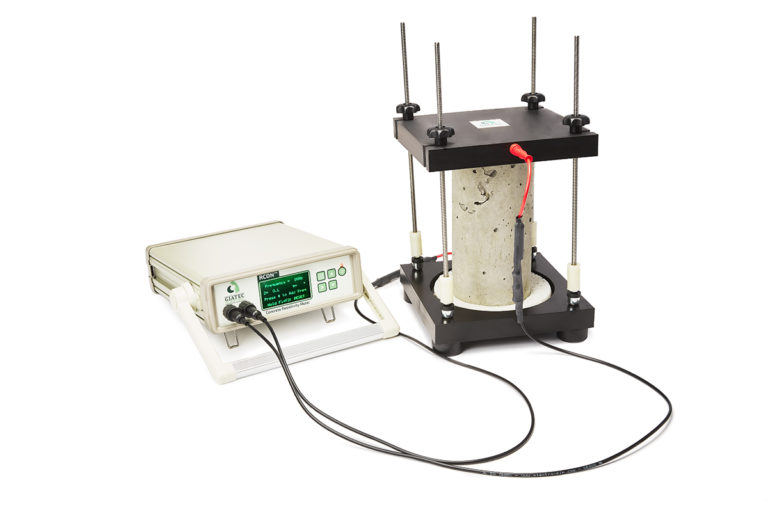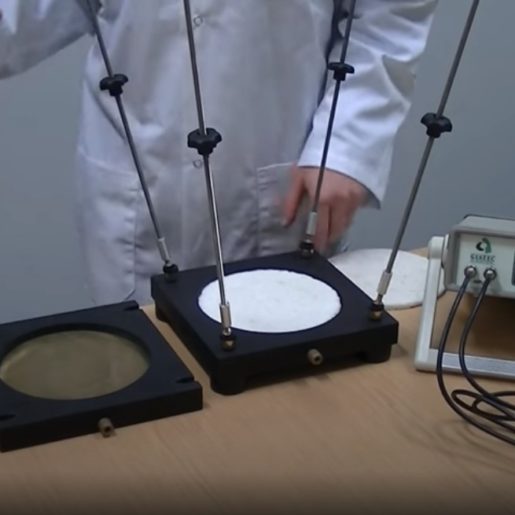RCON™
Bulk Electrical Resistivity Testing
Non-destructive laboratory device for measuring bulk electrical resistivity of concrete specimens
| Refresh | This website www.giatecscientific.com/products/concrete-ndt-devices/rcon-bulk-resistivity/ is currently offline. Cloudflare's Always Online™ shows a snapshot of this web page from the Internet Archive's Wayback Machine. To check for the live version, click Refresh. |
RCON™
Non-destructive laboratory device for measuring bulk electrical resistivity of concrete specimens

Fast & Accurate Measurements

Non-Destructive Technology

Customizable Setup

RCON™ is an advanced non-destructive laboratory tool for measuring the bulk electrical resistivity of concrete at various ages. The device is fast (measurement time is less than 5 seconds), accurate (utilizing a variable frequency method), and flexible (measurements can be taken with different settings for verification). No additional sample preparations are required before testing. RCON allows for continuous measurement of electrical resistivity over time, which can be used to monitor important durability parameters of concrete, such as; cracking, moisture transfer, and setting time in concrete specimens.

AASHTO TP 119 – Standard Method of Test for Electrical Resistivity of a Concrete Cylinder Tested in a Uniaxial Resistance Test
ASTM C1876 – Standard Test Method for Bulk Electrical Resistivity or Bulk Conductivity of Concrete
| Reading Range | Frequency spectrum | Phase measurement | Impedance accuracy | Phase accuracy |
| 1 ~100 Ω | 1Hz ~ 30KHz | 0 ~ 180° | ± 2% ± 2digit | 5 % ± 3digit |
| 100Ω~1000Ω | ||||
| 1 ~10 KΩ | ||||
| 10 ~ 100 KΩ | ||||
| 100 KΩ ~1 MΩ | 1Hz ~ 10KHz |
| Frequency | Sampling time | Reading time (minimum) |
| 1 Hz ~ 4 Hz | 5 seconds | 10 seconds |
| 5 Hz ~ 30 KHz | 1 second | 2 seconds |
| Part No. | Item | Description |
| 900083 | RCON – Full Package-115/230V | RCON unit, Power adapter, Test cable set, Alligator test clip, Sample holder, Verification kit, Fresh concrete probe, User manual, Communication PC software, USB cable, 2 bottles of conductive gels, 2 pairs of contact sponge |
| 900082 | RCON Device-115/230V | RCON unit, Power adapter, Test cables, Verification kit, User manual, Communication PC software, USB cable |
The following replacement parts are available upon request:
| Part No. | Item | Description |
| 900018 | Test Cable Set | A pair of test cable for connecting the device to the sample holder |
| 900065 | Verificaiton Kit | Required to verify the performance of the device |
| 900013 | Sample Holder – Bulk | Sample holder, 2 pairs of contact sponge |
| 900014 | Contact Sponge D150 – Pair | 150 mm Dia. Cellulose Sponge |
| 900015 | Conductive Gel – Low Viscosity | 250 ml bottle |
| 900016 | Conductive Gel – Medium Viscosity | 250 ml bottle |
| 900084 | Fresh Concrete Probe | Probe for testing electrical resistivity of fresh concrete |
| 900069 | RCON Fresh Concrete Test Rod Set | Stainless steel rods |
RCON is designed to test hardened concrete samples of different sizes and shapes for both laboratory and field applications.
Yes. There is a correlation between the results of the rapid chloride permeability test and those obtained from the electrical resistivity method.
No, it does not. RCON can easily and quickly measure the electrical resistivity of concrete. This parameter is closely correlated with the setting time of fresh concrete and the durability characteristics of hardened concrete.
RCON measures the electrical resistivity of concrete. This parameter can be used to estimate the durability and sustainability of concrete in a specific exposure environment. Giatec offers another device called Perma™ which measures the rapid chloride permeability of concrete based on the ASTM C1202. For more information on this device, please click here.
Using the special fresh concrete probe designed to be embedded in concrete, you can measure the water content and the setting time by monitoring the electrical resistivity versus time. The device comes with software that can log the data. However, calibration is required to correlate the change of the electrical resistivity to the actual water content and the setting time of concrete.
You can fit the cylindrical samples with the maximum size of 150mmx300mm and the cubic sample with the maximum size of 100mmx100mm in the regular sample holder that comes with the RCON. However, if you need to measure a 150mmx150mm cubic sample, we can customize the sample holder fixture in order to accommodate this size.
Only one sample can be tested at a time with the current test set-up that we have. However, the test is very fast, taking only 3-5 seconds to accurately process, allowing for many samples to be tested in a short period of time.
RCON is fully calibrated before shipping and, moreover, comes with a verification kit for the customer to verify the test results from time to time if deemed necessary. The device has been designed to provide high sensitivity and accuracy required for concrete research.
The conductivity of fresh concrete (which is the inverse of its electrical resistivity) can be measured using the fresh concrete probe provided by Giatec or using a similar setup. This fixture incorporates two stainless steel rods (with insulating parts at the ends) embedded in fresh concrete. The rods are connected to the RCON device for monitoring the increase in the electrical resistance between them as the concrete sets and hardens. The measured electrical resistance can be converted to electrical resistivity knowing the conversion factor which depends on the geometry of the test container. This conversion factor can be easily obtained by measuring the electrical resistance of a salt solution (with known conductivity) in the test container.
Now’s your chance to start building smarter. Get started today to see if you qualify.